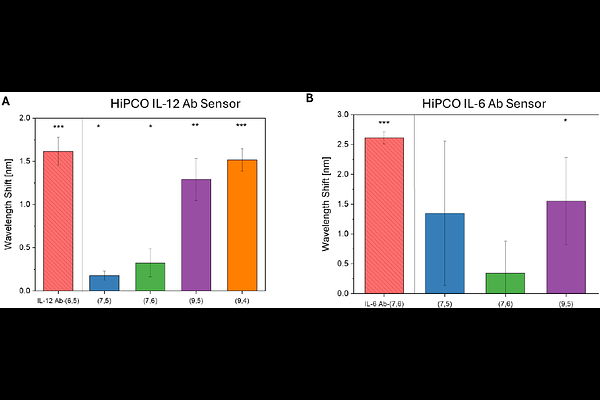Multiplexed Molecularly-Specific SWCNT Cytokine Sensing is Enabled and Enhanced by Amine-Functionalized DNA Aqueous Two-Phase Extraction

Multiplexed Molecularly-Specific SWCNT Cytokine Sensing is Enabled and Enhanced by Amine-Functionalized DNA Aqueous Two-Phase Extraction
Ryan, A.; Parveen, S.; Cohen, Z.; Israel, A.; Williams, R. M.
AbstractSingle-walled carbon nanotubes (SWCNT) are versatile building blocks for optical sensors. Their carbon lattice structure, denoted by chiral (n,m) indices, determines the wavelength of their near infrared fluorescence emission. Commercially available SWCNT are polydisperse, containing many (n,m) species with overlapping fluorescence peaks, leading to spectral congestion. Aqueous two-phase extraction (ATPE) has emerged as a valuable tool to sort SWCNT according to their chiral structure and promises improved nanosensor performance as well as unique opportunities for multiplexing. Previous applications of ATPE have enabled ratiometric sensors, but simultaneous detection of multiple analytes using distinct SWCNT chiralities has yet to be realized. This hurdle is largely due to the contrasting surface chemistries needed for ATPE sorting and those needed for biosensing applications. In this work, we introduce a method for purifying multiple chiralities of SWCNT which can be functionalized with molecularly specific antibodies to create a multiplexed sensor platform. We utilize aminated DNA (DNA-NH2), which serves as both a conduit for ATPE sorting and an intermediate linker for later antibody conjugation, to realize this goal. We demonstrate that chemically modified DNA enables ATPE sorting, supporting the broad future utility of the technique. We further show that chirality-sorted SWCNT-DNA-NH2 serve as excellent base constructs for antibody conjugation, forming highly specific sensors with enhanced optical properties (compared to unsorted SWCNT sensors). Importantly, one batch of monochiral base constructs can be functionalized with different antibodies towards different biological applications. Finally, we show that we can sort and functionalize two separate SWCNT chiralities and combine them together to create a multiplexed sensor platform where each peak responds distinctly to its target. There are vast opportunities for expansion of this work through the use of alternative DNA sequences to enable sorting, various SWCNT chiralities, and virtually any commercially available antibody for molecular recognition.